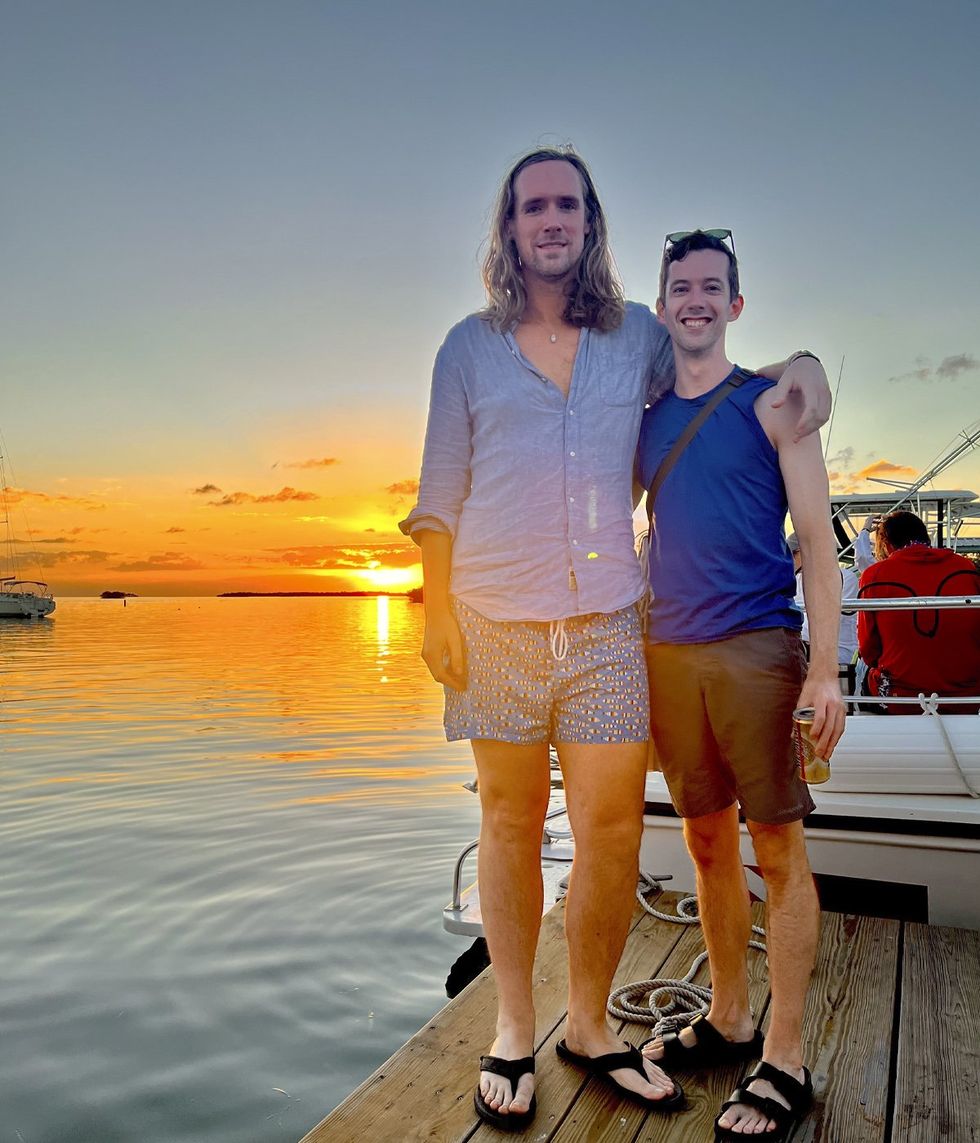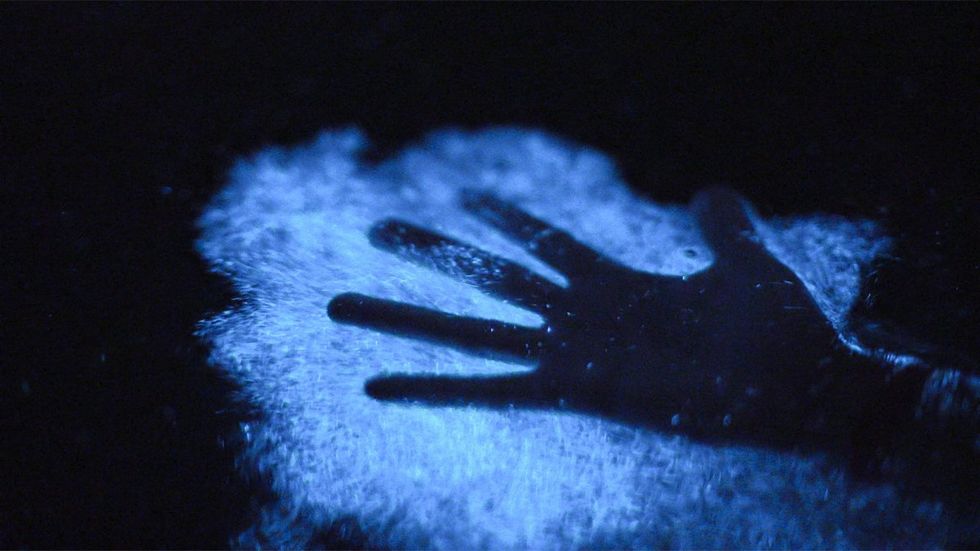

The setting sun over the shores of La Parguera — a charming fishing village within the Lajas municipality, two hours from San Juan — was truly a sight to behold. The colors, reflected in watercolor waves, shifted with each moment. Turquoise lapped into yellow hues and fiery golds. “This is the shot,” the tour guide urged. My travel mate and I put down our snack of empanadas, hopped back onto the deck, and smiled for the camera. And voila, the perfect shot of a sunset in paradise.
 Courtesy Daniel Reynolds
Courtesy Daniel Reynolds
However dazzling, the sunset was not the raison d’être for our evening Paradise Scuba & Snorkeling Center cruise. It was, in fact, only the inciting incident. As the sea finished its swallow of the sun, our ship steered away from port. Our destination? The bioluminescent bay, a wonder of the natural world that is part of protected land in La Parguera Nature Reserve.
The Bio Bay is a rare breeding ground for billions of single-celled organisms called dinoflagellates. (There are three bioluminescent sites located in Puerto Rico, a testament to the Caribbean island’s rich biodiversity.) Classified as a form of algae, dinoflagellates in large concentrations can alter the color of water. Some types, like a “red tide,” can be toxic, but the eco-friendly kind in the Bio Bay simply sparks dazzling blue-green light when agitated. Invisible to the eye in the daytime, the dinoflagellates create an Avatar-esque wonderland at night for living things swimming through its waters. Protected from the sea by a coral reef, the bay has a unique blend of ingredients known to have beneficial glow-ups for hair and skin, the tour guide claimed as we motored toward our destination.
There, on the right, were the Isla Magueyes Laboratories, facilities where marine researchers study the Bio Bay and its many mysteries. Human habitations are prohibited along the shoreline, which is considered public property. But on our left, dwellings dotted the coast, their lanterned decks lapped by the water. The construction of these abodes either predated the advent of 21st-century property laws or its residents simply viewed corresponding fines as an acceptable cost of coastal living, explained the boat’s driver. He recalled how, after the devastation wrought by Hurricane Maria in 2017, communities were quick to repair and even improve houses before inspectors could move in.
The last lights of human habitation faded away as the boat moved deeper into the bay. Darkness is the key ingredient to bioluminescence. Too many stars, or too full of a moon, and the Bio Bay’s nighttime glow is muted. As we neared the center of the darkening body of water, the captain turned off the ship’s motor and lights. “Stay close,” he cautioned. Other tour boats floated not far from ours and might not spot a swimmer in the nighttime.
I was the first to jump in, grabbing a snorkel mask but turning down the life jacket. The saline content was high enough to make floating relatively easy. At first, I didn’t notice any change. It was the awed reactions from my boatmates that alerted me to the magic forming around me. “Make an angel,” urged our guide. Floating on my back, I moved my arms and legs like a kid in the snow. And then, I saw it, my body surrounded by light.
For the better part of an hour, my boatmates and I splashed around, watching light emanating from our hands like wizards in a CGI fantasy film. A few on our tour opted to stay on the ship. They liked to see other folks jump in, the guide explained, but weren’t comfortable with the dark water below. Anxieties over unseen sea creatures have unsettled me in the past, but I was unbothered in the Bio Bay. The experience was just plain fun. In the quiet moments, as I floated in bioluminescence and gazed skyward, I felt an emotion akin to enlightenment. There we were, organisms glowing on our planet, connecting with the celestial bodies overhead.
 Courtesy Discover Puerto Rico
Courtesy Discover Puerto Rico
Discovering the Magic of Puerto Rico's Bioluminescent Bay

The setting sun over the shores of La Parguera — a charming fishing village within the Lajas municipality, two hours from San Juan — was truly a sight to behold. The colors, reflected in watercolor waves, shifted with each moment. Turquoise lapped into yellow hues and fiery golds. “This is the shot,” the tour guide urged. My travel mate and I put down our snack of empanadas, hopped back onto the deck, and smiled for the camera. And voila, the perfect shot of a sunset in paradise.
 Courtesy Daniel Reynolds
Courtesy Daniel Reynolds
However dazzling, the sunset was not the raison d’être for our evening Paradise Scuba & Snorkeling Center cruise. It was, in fact, only the inciting incident. As the sea finished its swallow of the sun, our ship steered away from port. Our destination? The bioluminescent bay, a wonder of the natural world that is part of protected land in La Parguera Nature Reserve.
The Bio Bay is a rare breeding ground for billions of single-celled organisms called dinoflagellates. (There are three bioluminescent sites located in Puerto Rico, a testament to the Caribbean island’s rich biodiversity.) Classified as a form of algae, dinoflagellates in large concentrations can alter the color of water. Some types, like a “red tide,” can be toxic, but the eco-friendly kind in the Bio Bay simply sparks dazzling blue-green light when agitated. Invisible to the eye in the daytime, the dinoflagellates create an Avatar-esque wonderland at night for living things swimming through its waters. Protected from the sea by a coral reef, the bay has a unique blend of ingredients known to have beneficial glow-ups for hair and skin, the tour guide claimed as we motored toward our destination.
There, on the right, were the Isla Magueyes Laboratories, facilities where marine researchers study the Bio Bay and its many mysteries. Human habitations are prohibited along the shoreline, which is considered public property. But on our left, dwellings dotted the coast, their lanterned decks lapped by the water. The construction of these abodes either predated the advent of 21st-century property laws or its residents simply viewed corresponding fines as an acceptable cost of coastal living, explained the boat’s driver. He recalled how, after the devastation wrought by Hurricane Maria in 2017, communities were quick to repair and even improve houses before inspectors could move in.
The last lights of human habitation faded away as the boat moved deeper into the bay. Darkness is the key ingredient to bioluminescence. Too many stars, or too full of a moon, and the Bio Bay’s nighttime glow is muted. As we neared the center of the darkening body of water, the captain turned off the ship’s motor and lights. “Stay close,” he cautioned. Other tour boats floated not far from ours and might not spot a swimmer in the nighttime.
I was the first to jump in, grabbing a snorkel mask but turning down the life jacket. The saline content was high enough to make floating relatively easy. At first, I didn’t notice any change. It was the awed reactions from my boatmates that alerted me to the magic forming around me. “Make an angel,” urged our guide. Floating on my back, I moved my arms and legs like a kid in the snow. And then, I saw it, my body surrounded by light.
For the better part of an hour, my boatmates and I splashed around, watching light emanating from our hands like wizards in a CGI fantasy film. A few on our tour opted to stay on the ship. They liked to see other folks jump in, the guide explained, but weren’t comfortable with the dark water below. Anxieties over unseen sea creatures have unsettled me in the past, but I was unbothered in the Bio Bay. The experience was just plain fun. In the quiet moments, as I floated in bioluminescence and gazed skyward, I felt an emotion akin to enlightenment. There we were, organisms glowing on our planet, connecting with the celestial bodies overhead.
 Courtesy Discover Puerto Rico
Courtesy Discover Puerto Rico


Post a Comment